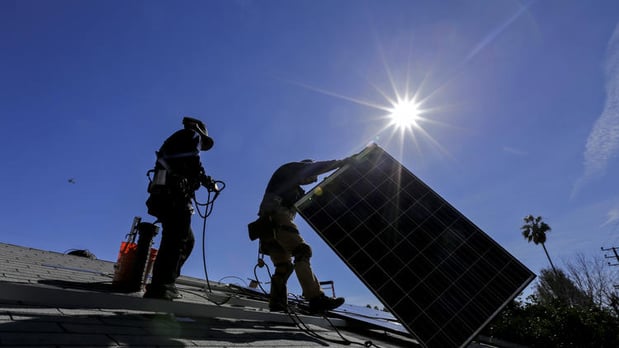
A crew from Sunrun home solar company installs a solar system on a Van Nuys house.
Like some kind of 21st century Willy Wonka, audacious entrepreneur Elon Muskchose a prime spot on the Universal Studios Hollywood backlot tour to unveil his latest attempt to energize an industry — roofs that generate solar power but look like no other.
Musk, the chief executive of Tesla Motors and chairman of SolarCity, showcased a line of high-design solar roof tiles that would replace clunky solar panels and tie into an upgraded version of the Tesla wall-mounted battery for those times when the sun doesn’t shine. The glass solar shingles resemble French slate, Tuscan barrel tile or more conventional roofing materials with a textured or smooth surface.
“The key is to make solar look good,” Musk said during the product introduction staged on the old set of ABC’s “Desperate Housewives” series, where he had re-roofed four of the Wisteria Lane houses. “If this is done right, all roofs will have solar.”

At Universal Studios Hollywood's old "Desperate Housewives" set, Tesla CEO Elon Musk shows off a new solar tile roof to be produced by SolarCity, which Tesla is buying. Four Wisteria Lane homes on the set were re-roofed with the tiles.
The move comes as California’s solar industry grapples with slowing growth and other challenges despite aggressive state mandates to boost the use of renewable energy.
Nationwide, sales of residential solar panels have held fairly steady in the year ended June 30, according to the Solar Energy Industries Assn.
In California, solar photovoltaic panel sales rose 12% in the first nine months of 2016 compared with the same period of 2015, state data show. But that pales compared with the 66% jump in the first three quarters of 2015 compared with the same period a year earlier.
Experts attribute the slowing to depletion of the pool of early adopters as well as to policy changes in California and other states governing how solar owners are compensated for electricity they produce and sell to utility companies.
In addition, many homeowners were worried whether Congress would renew a 30% federal tax credit set to expire at the end of 2016. Congress extended the credit through 2019 at 30%, after which it gradually phases out for residential solar customers.
The California solar industry still expects 2016 to finish with an expansion.
“We’re seeing a slowdown in the market but it’s not a downturn,” said Bernadette del Chiaro, executive director of the California Solar Energy Industries Assn. “We’re going to install more rooftop solar this year than we did in 2015.”
A significant driver in the solar market is the continued drop in the price of solar panels. The typical residential solar system runs about $8,000 with government incentives, including the 30% federal tax credit.
The supply of solar panels for residential and other uses almost doubled from 32 gigawatts in 2012 to 60 gigawatts in 2015, according to Navigant Research of Chicago. That’s enough to power roughly 45 million homes.
